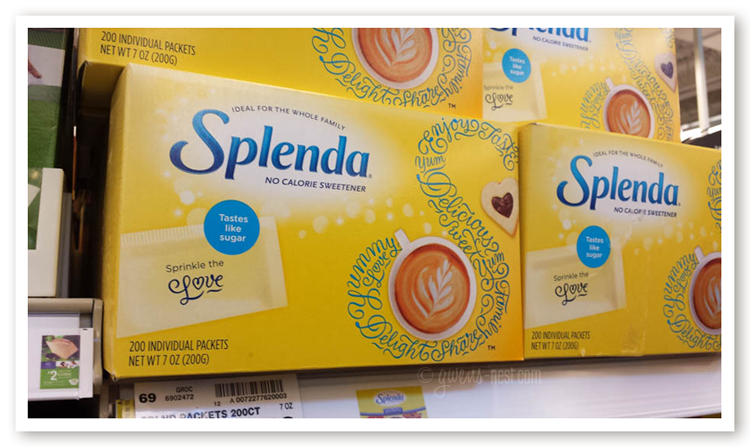 Splenda side effects- today I’m answering a reader question here on Gwen’s Nest. And BOY did I learn a lot researching this post!
Splenda side effects- today I’m answering a reader question here on Gwen’s Nest. And BOY did I learn a lot researching this post!
Why is splenda not liked on the [Trim Healthy Mama] plan? Trying to find this answer everywhere.
Full Disclosure: This post may contain affiliate links. We are a participant in the Amazon Services LLC Associates Program, an affiliate advertising program designed to provide a means for us to earn fees by linking to Amazon.com and affiliated sites. Disclosure Page~Elizabeth
This is a GREAT question, Elizabeth! I know that the Trim Healthy Mama plan has, from the start, always recommended natural sourced sweeteners, like stevia, erythritol, and xylitol.
I also remember reading the story in the original book about a woman who loved her Splenda, and wasn’t willing to change sweeteners. And the plan still worked for her. But I wondered why this was not one of the recommended sweeteners, because it *is* sourced originally from sugar.
So where does the truth lie? In my research, I discovered that there is a lot of controversy over the safety of sucralose, and potential Splenda side effects. I really, truly wish it was a quick, simple answer that I could tie up in a little bow.
But alas. My search for sucralose pulled up over 550 studies on the U.S. National Library of Medicine site. So instead of combing through every single study, I’m going to focus in on the main conclusions and supporting evidence from the two main schools of thought on this topic.
I’ll do my best to give you the short & sweet of both camps, and leave you to make your own decision on what non-caloric sweetener to use.
Splenda Safety
Let’s call the first camp the Splenda Safety camp. In this corner, we find the manufacturer, the FDA, and a body of researchers who stand behind sucralose as a thoroughly tested and safe artificial sweetener. I’ll let the Splenda website summarize their position:
A review of an extensive body of evidence concludes that sucralose, the sweetening ingredient in SPLENDA® Sweetener Products, is safe for use by the entire population without exception.1
Now, there are a lot of angles that the research seeks to gain insight on, as far as how intake of Splenda may affect blood glucose response, weight loss, cravings, and more. With Splenda’s fat 62% share of the huge non nutritive sweetener market, there has been a LOT of well funded research.4 In fact, Splenda “was subjected to one of the most extensive and thorough safety testing programs ever conducted on a food additive.”2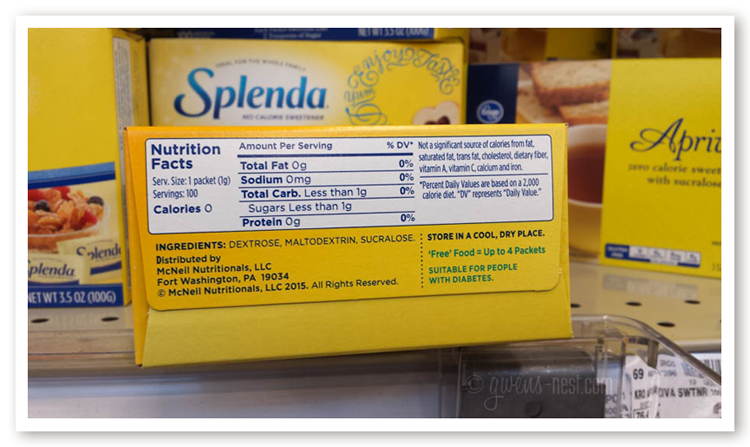
And while we’re at it, the topic of how sucralose is used and broken down by the body has become a major sticking point in the other camp. So let’s lay out the Splenda Safety position there too, outlined on the Splenda blog by author Robyn Flipse, a registered nutritionist:
Sucralose is water soluble and it does not accumulate in the body and is not broken down for energy – so it has no calories. About 85% of the sucralose we consume is excreted in our stool unchanged, while the remaining 15% is passively absorbed then excreted quickly in the urine. It is eliminated rapidly from the body.3
Splenda Safety: Conclusion
So, tied up in a neat little bow: the Splenda Safety camp is super sure that Splenda and sucralose is safe for human consumption. Brought to you by the the makers of Splenda, who own 62% of the billion dollar non-nutritive sweetener market.4
Splenda Dangers
Let’s call the second camp Splenda Dangers. In this corner is a smattering of researchers, independent consumer watchdog groups, and internet health gurus who are skeptical about the wholesale support of the product, and concerned that possibly some of the long term health risks have not yet been thoroughly tested.
Also in this corner is the sugar industry, partially funding one of the key studies that is pushing back on the Splenda Safety camp.
So what *are* the concerns that are being raised about Splenda and sucralose? 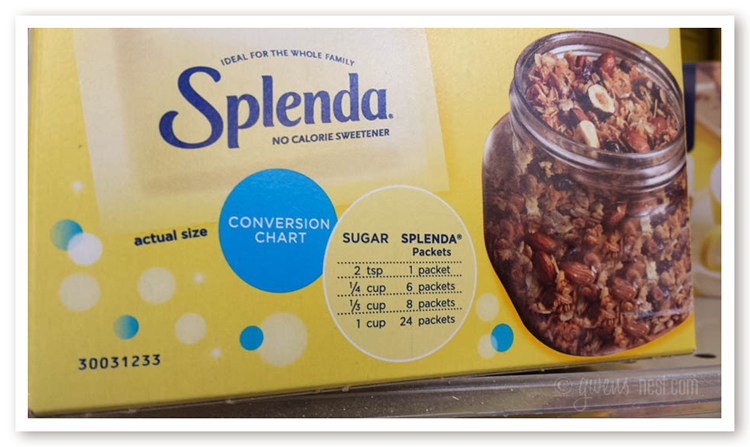
The original conclusions that Splenda and sucralose are not metabolized in the body. But the idea that there are no Splenda side effects is beginning to be challenged by a body of refuting research. Results seem to indicate that sucralose or Splenda may be metabolized…it may be more biologically active than we first though. There may be Splenda side effects after all. Concerns include:
- A reduction in beneficial gut bacteria
- Meds rendered less effective
- Toxins released when heated
Let’s look quickly at each of these concerns.
Possible Splenda Side Effects
Altered Gut Flora
In a 2013 study by coauthor Susan S. Schiffman, PhD, an adjunct professor at North Carolina State University and four other researchers, there are indeed Splenda side effects. The amounts of sucralose within the FDA safety guidelines can reduce the number of healthy gut flora (the same beneficial bacteria found in yogurt) by up to 50%.5
To be fair, let’s put the study into perspective. The Shiffman study was done on rats, and not humans. But so are the studies that the FDA uses to support the safety of sucralose. So the playing field is level in that regard. The study also relied on amounts that are approved for use in food and not megadoses. According to Dr. Schiffman,
drinking the equivalent of less than one diet soda per day was found to reduce good gut bacteria, and two diet sodas a day could limit drug absorption.6
There has been a formal rebuttal of the study by an “expert panel” who “conducted a rigorous evaluation of this study. In arriving at its conclusions, the Expert Panel considered the design and conduct of the study, its outcomes and the outcomes reported in other data available publicly.” (I have not been able to actually find anything available publicly aside from the study abstract.) The expert panel did not disclose their affiliations, and not surprisingly, concluded that, “The study conclusions are not consistent with published literature and not supported by the data presented.”7 (Shocking)
I don’t usually lean toward the conspiracy theories, but I wonder if the panel of experts would have bothered to even look at the report if it was “consistent with published literature.”
Limiting Drug Absorption
From the study summary:
Evidence indicates that a 12-wk administration of Splenda exerted numerous adverse effects, including (1) reduction in beneficial fecal microflora, (2) increased fecal pH, and (3) enhanced expression levels of P-gp, CYP3A4, and CYP2D1, which are known to limit the bioavailability of orally administered drugs…These changes occurred at Splenda dosages that contained sucralose at 1.1-11 mg/kg (the US FDA Acceptable Daily Intake for sucralose is 5 mg/kg).
This seems to me to be a fairly straightforward thing to be able to test in human trials.
<knock knock> Hello? FDA? Is anybody home in there? Can we get some non-biased insights and additional testing here please?
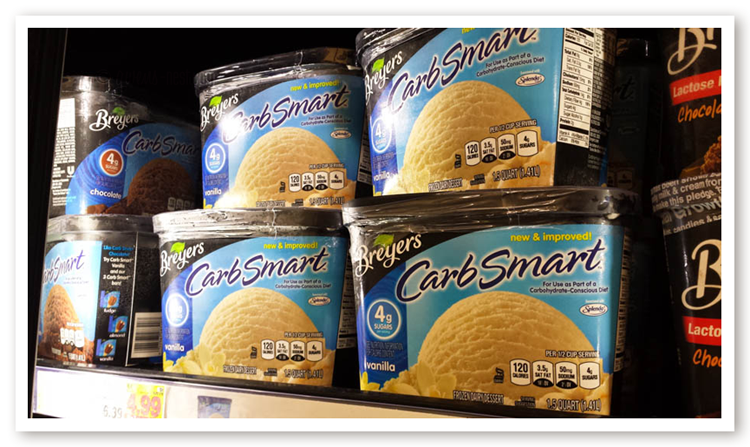
Toxins Released When Heated
Splenda is sold as a baking friendly “heat stable” non-nutritive sweetener. I very much appreciate when terms are defined, so let’s start by defining “heat stable,” according to the FDA:
[Sucralose] is heat stable, meaning that it stays sweet even when used at high temperatures during baking.8
Mmmm-k. Oh dear. Dear, dear FDA. Staying sweet is nice and all, but let’s look at this on a little deeper level. I’d really like to know if it’s *safe* to heat it and eat it.
One study says no…or at least it strongly infers that more needs to be known about Splenda side effects when baked and heated. The study…
revealed that there is effective decomposition in form of CO2 along with the formation of hydrogen chloride and other minor compounds. These findings not only corroborate the suspected instability of sucralose to high temperatures, but also indicate that even exposed to mild conditions the formation of hazardous polychlorinated compounds is observed.9
The study has been published since 2008, with no additional research or change in the FDA safety ratings. Splenda is still being sold as safe for baking.
And More Possible Splenda Side Effects
And details on new research are continuing to emerge. At the time of this writing, the Center for Science in the Public Interest (CPSI), a non-profit that tracks the safety of food additives and chemicals, has downgraded sucralose from the “caution” category to the “avoid” category with the release of a newly published study linking sucralose to leukemia and blood cancers in mice.
According to CSPI, the new study is more powerful than the industry-funded studies, which tested fewer animals, started exposing the animals beginning at adolescence as opposed to in utero, and ended earlier in the animals’ lives.10
The CPSI publishes the ChemCuisine ratings list. They currently rate non-nutritive sweeteners is as follows.
- Safe: stevia, erythritol
- Cut Back: xylitol
- Caution: monk fruit (not enough studies for long term use)
- Avoid list: acesulfame-potassium, saccharin, sucralose (Splenda), aspartame (Nutra Ssweet)
Splenda & the Trim Healthy Mama Plan
The THM plan is about improving overall health, and the authors consider natural sweeteners to be a healthier option long term. And I have to say that I fully agree with them.
Some have wondered if Splenda actually qualifies as a natural sweetener option, since (as their marketing suggests) it’s made from sugar. Turns out, it’s made in a chemical process using sugar and chlorine.
The core ingredient, sucralose, is manufactured in laboratories as a synthetic compound.4
According to the manufacturer, McNiel (a division of Johnson & Johnson),
“the sweetening ingredient in Splenda is made by a multistep process that starts with cane sugar.” But it then added that “Splenda is an artificial sweetener that does not contain sugar”4
“But WAIT”…you might say. “Splenda is NOT off plan for a Trim Healthy Mama!” And you’d be right! A couple of the (for occasional use only) convenience foods on the plan *do* contain Splenda, like the Carb Smart Ice Cream. And I know many ladies enjoy using the Walton Farms and other sugar free dressings, ketchups, and even the sugar free coffee syrup options at the local coffee shop. I myself have enjoyed a diet Lemonade at Chick-fil-a on occasion.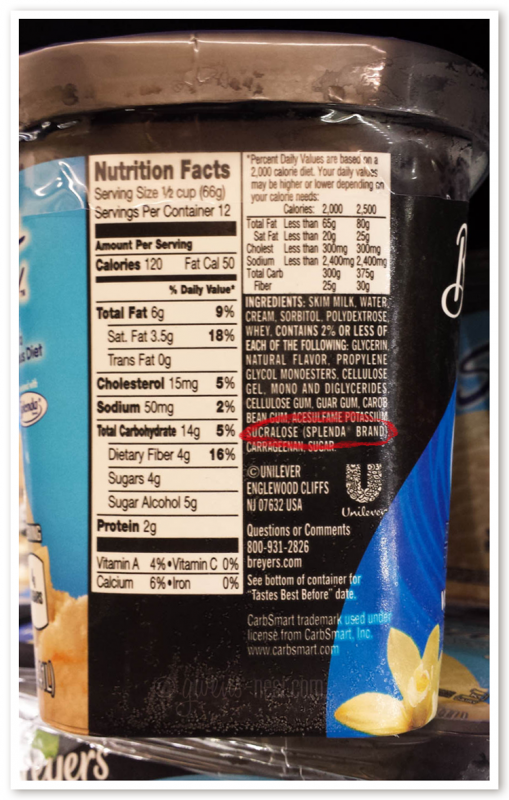
But the key word is “on occasion.” Splenda is not promoted as an approved THM sweetener, but it’s considered a personal choice option for those who enjoy it on occasion. And after researching this article, I think my occasions will be very few and far between. The possible Splenda side effects are just not very appealing.
I’m going to be more proactive about avoiding Splenda, and will choose the (also THM approved for occasional use) SO Delicious, no sugar added ice cream. And I’ve found that making my own salad dressings (like this AMAZING Greek and ranch dressing mixes that I make in bulk) are super tasty and very convenient.
Conclusion
While Splenda is non-caloric, it is an artificial sweetener that may pose some risk. Splenda side effects are still not fully known, and more research is needed to build a more thorough understanding of how it’s metabolized, how it performs in baking and heating, and the effects of long term use. I prefer to stick with alternative sweeteners like stevia and erythritol.
To Pin & Share!
Was this article helpful to you? Thank you for sharing and pinning! I’d love to hear your thoughts in the comments. Do you use Splenda? Do you feel it’s a safe option for occasional use?
Sources Cited
- http://www.splendaprofessional.com/studies
- http://www.splendaprofessional.com/safetystudies
- Sucralose dangers and side effects, Flipse, Robyn (May 19, 2014) https://blog.splenda.com/fact-vs-fiction-sucralose-dangers-and-side-effects
- Splenda market share: Browning, Lynnley (April 6, 2007), Makers of Artificial Sweeteners Go to Court, New York Times Business section
- Shiffman Study -Gut Flora & Meds (2001) http://www.ncbi.nlm.nih.gov/pubmed/18800291
- Shiffman quoted on amounts used (December 17, 2013) http://www.prevention.com/food/healthy-eating-tips/health-risks-sucralose
- Expert Panel Rebuttal (October 2009) http://www.ncbi.nlm.nih.gov/pubmed/19567260
- Sucralose Heat Stable FDA Definition: http://www.fda.gov/Food/IngredientsPackagingLabeling/FoodAdditivesIngredients/ucm397725.htm#Sucralose
- Heat Stability Sucralose Study http://www.ncbi.nlm.nih.gov/pmc/articles/PMC4397539/
- CSPI & lukemia study published http://cspinet.org/new/201602081.html
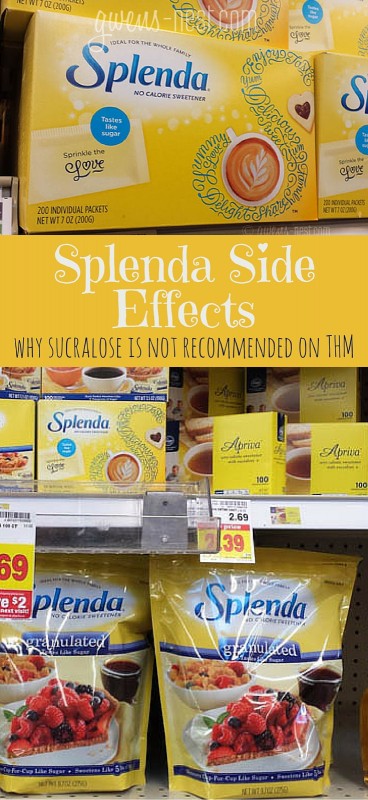
Great article! I’m always happy to see people who present both sides of an argument intelligently and unbiasedly.
Commenting on how you said you have trouble finding full versions of some of the studies… I could help. I’m a university student and the university pays for a lot of those subscriptions. If you ever want to read the full version of something let me know and I’ll see if I can email you a pdf. Chances are I’ll be looking at similar studies anyway because my blog is focussed on presenting the scientific evaluation of these things.
Rachel! That would be FABULOUS! I’d love to look at the full version of the Shiffman study looking at gut flora. Thank you! You can contact me at gwens.nest.blog (at) gmail.com
I am not doing THM yet. The problem being that erythritol hurts my tummy sooooooooo badly.
Stevia seems to be ok. But, is it possible to do this with stevia only?
Does anyone have tummy issues with erythritol or xylitol?I haven’t consumed Splenda enough to know. That wasn’t an option that I thought of at all.
What can I do to make this work?
Hi Cathi,
You really do have to listen to your body. Even if a sweetener is rated as “safe”, if you’re allergic or intolerant, it’s not the right choice for you. It is possible to use only stevia, but the baking is trickier without a bulkier sugar sub. If you try xylitol, just be aware that you should start very small. Monk fruit is another good one to look at, but oftentimes the super concentrated sweeteners like stevia & monk fruit (aka lo han) are cut in with erythritol as a bulking agent.
There is a new product that’s Stevia cut with sugar, but it’s no-cal. And it’s pretty yummy! It’s called Zing.
I just found your site and love it. I am on day 10 of withdrawing from sugar and a 30-year 6-9 pack a day of sweet-n-low. The biggest issue has been fatigue, mild headaches and foggy thoughts. I too am a size 16 muffin top and said I would not buy a new size. My 30 year wedding anniversary is in Nobember and I am determined to be 40 lbs less, healthier and an example for my son. I have 4 children also and watched as I went from a size 3 with the first to a size 14 with the last – 16 years apart. I actually started my diet on April 1st getting rid of fried foods first. I Was walking about 3 miles a day and After I easily got rid of fried fatty foods and sweets I did research and I realized the sugar had to go so here I am 23 days later but only 10 off sugar. On day 3 I cratered and was floored. I started looking at withdrawal symptoms to understand and keep going. I am down 8 lbs and looking for sugar free syrup recipes as I am craving sweets. Thank you for sharing your journey especially how the first month was hard and you made mistakes. Today is the first day I am starting to feel better. I am so fortunate that my husband has supported me and encouraged my progress while also having to do double duty because of my fatigue and help shop and cook. He joined with me cus he needed to lose weight also and is already down a pants size. Men ugh it’s easier for them and maybe because he’s had to do extra work lately 🙂 but I am happy for him. He also never used artificial sweetners so he hasn’t had that withdrawal issue. We promised each other we would prop the other one up when it got hard which is the story of our 30-year marriage in a nutshell. I will be using your recipes and buying the cookbook. Thanks so much it means a lot right now. I love the before and after pics. I have already taken my before pic and plan to document my progress as well to keep me motivated.
thank you so much Gwen! I really appreciate your research into this.
I have eaten a ton of artificial sweeteners my whole life. My family was a “guinea pig” family for NutraSweet when it was invented as my mom worked at a patent law firm and they represented the makers. She brought home tons of gumballs for us to eat – all sweetened with NutraSweet. Then I switched to Splenda when it came out because I started hearing about all the bad side effects of NutraSweet and of course, believed everything was safe.
About 8 years ago I was diagnosed with a HUGE ovarian tumor the size of a 2-liter bottle of soda. Luckily, it was non-cancerous and full of thyroid “material” (my thyroid was never effected however), but it stumped my doctor as he’d never seen anything like it that wasn’t cancer.
I’m beginning to believe it was probably caused by all of the artificial sweeteners I’ve eaten all my life and as I still sit with a coffee from 7-11 in front of me FULL of Splenda (my THM Super Sweet is at home for my morning coffee and I have more here at work for my mid-morning coffee – but when I go out – I use Splenda), I am now thinking that Splenda is going to be avoided by me from now on!
Thanks for the unbiased look at all of this back and forth claims of safety – I don’t think I’m going to risk another tumor!
Oh GOODNESS, Kim! That’s incredible. I’ve never heard of a tumor full of thyroid material. Very freaky!
Thanks for all the research you did! I have often wondered about Splenda and thm. Very informative post!
Yes, this article was very helpful! Thank you for taking the time to do the research digging.
Great study–Final thought Why risk your health if you are trying to ‘get healthy’?! I’m the purist and don’t want to consume the chlorine bleach molecules that are residual from making white sugar into Splenda- which is a non-food substance that my body can’t utilize anyway. I’d use the recommended THM sweetners!
I really appreciate you doing the research on this! This is something I have wondered about and you summed it up very nicely. Thanks so much!
By the way, I would LOVE to see a similar post about Xylitol! I love that stuff!
I avoid Splenda like the plague-the risks aren’t worth it to me! 🙂
I knew a man who was a degreed Chemist and subscribed to a magazine designed specifically for Science majors. Several years ago when Splenda hit the market and the sugar industry was crucified, he began to see multiple offers in this publication aimed at graduate students who needed a project for their thesis. Sponsored by the sugar industry they offered fully funded research and expenses to anyone who could prove something was wrong with Splenda. Nothing was questioned. Just find something wrong with it. Is this still going on? Don’t know. Is this why some studies still have questions? Don’t know. Is it really safe/not safe? Don’t know. Just saying that sometimes you can prove whatever you want if you start out with preconceived ideas. Sometimes it really is hard to know who or what to believe.
Oh, I completely understand that both sides of this debate have MAJOR amounts of money on the line. I realize that there are politics in business, and business in politics. I’m just sharing both sides, with no disclaimer as to whether or not either side is squeaky clean.
🙂
Totally agree with this. I believe we tend to be like sheep and follow wherever we are lead. You can find as many studies as you care to read supporting or bashing everything and anything. When funding is provided for a study by one side or another, it will only be studies that actually support the outcome they want that will be published and made public. We really have no clue as to the real truth.
Thanks for tackling this! I’m amazed how much misinformation is out there on Sucralose… most people don’t even know it’s made from chlorine.
I know some people seem to be asymptomatic when taking Splenda (like a relative of mine with diabetes who’s been using it for years) and for those I still encourage caution.
But my husband is one of the tens (probably hundreds by now) of thousands of Americans who suffer severe neurotoxic side effects from Sucralose. These can include fast heartbeat, cold sweats, and being suicidal (even without depression)…. among other things.
I’ve encountered numerous people who were experiencing many of the neurotoxin side effects who did not know this about Sucralose and were trying to justify their symptoms as menopause, etc. After I shared my husband’s experience with a former employer of mine she gave up her Splenda sweetened diet soda habit and the symptoms cleared up in two days and stayed gone.
I’m so glad to have stevia, erythritol etc. as healthier sugar alternatives!
Great insights, Beth! Until reading the comments, I hadn’t realized that people reacted so seriously to Sucralose. Scary!
When baking I usually use a mix of Splenda and Xylitol, but just bought some erythritol and am incorporating it in. The Splenda is almost gone and probably won’t buy any more of it. Especially after reading your study. I have an older bottle of Kal Stevia and it is pure not mixed with dex… whatever. I’m really trying to get used to the taste of most stevia products. The Pure stevia from Kal is pretty good. One little scoop is all it takes.
Thanks for you diligence in helping to make us healthy.
The old Kal and NOW brands were good. I also like just a little stevia mixed in with either erythritol or xylitol. 🙂 Great job on transitioning!
Great post!
As soon as I read, a year or so ago, that Splenda was accidently discovered in a lab when researchers were trying to make a new pesticide (WHICH IS TRUE!!!), that was enough to get it our of our diet. Just stevia, raw honey and the occasional turbinado sugar for baking in our house.
I noticed scine I stopped drinking diet soda, my meds are working better & I don’t use sleeping meds anymore but fall asleep quickly & wake in 8-9 hours
So…we’re in a country where we can’t get stevia or erythritol. Is it better to use Splenda or sugar?
Sugar is going to raise your blood sugar levels and insulin levels, and Splenda has side effects. Are there other options? Monk Fruit maybe?
Hi Gwen! Have you heard of Sugavida? My doctor recommended it to me. It’s not inexpensive by any means, but worth a peek! It’s from India..available through Vitamin Shoppe. I love the taste!
It’s lower glycemic than white sugar, but similar to coconut palm sugar…from my reading it’s more environmentally friendly though. 🙂 It wouldn’t be a great fit for the weight loss phase of the Trim Healthy Mama plan, but I’d definitely consider it for those wanting to put on weight, or for kids. 🙂 Thanks for letting me know about it!
SugaVida actually helps to normalise weight as it helps body to produce leptin. It also helps liver to produce glucuronic acid that is how body helps to expel toxins – how will you know? – your skin, hair and nails start to improve dramatically after 3 weeks of continuous use. Coincidentally, this is why the most profitable modelling agency in Europe – Storm Modelling- been recommending it to its models for the past few years.
Is SugaVida available in the US? I’d like to try it.
Thank for the clarification!
Gwen, I started THM on Christmas Eve 2016. I’ve lost 23 lbs so far! I found out about THM partly from your cornbread post that my childhood Christian friend had shared on Facebook, and partly from watching Jamerrill Stewart’s vlogs. I’m trying to help my Grandparents who are in their 70’s, switch to mineral salt and go sugar free, for starters. They give my kids all kinds of processed junk and straight sugar… my eldest daughter is struggling at 5 years old with childhood obesity because of it. Would you recommend the original THM book (which I’ve never read), or the condensed Plan book (which I have and am halfway through)? My Grandma almost needs the science behind it all in order to be convinced that eating a teaspoon of sugar to raise her blood sugar when it dips, is really not okay… I didn’t know if you started with the big original book, but I thought if you had, you would be a good person to ask. Thanks in advance!
The plan book is going to be easier for her to follow. 🙂 The original book is kind of an information beast…like drinking out of a firehose. 🙂
I’m not sure if this Snopes article will be of interest…but I thought it was!
I don’t consider Snopes to be a trustworthy source of information.
This was so helpful to read! Thank you for taking the time to research this topic and share your findings!